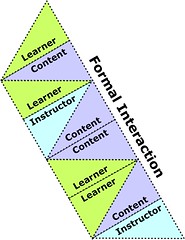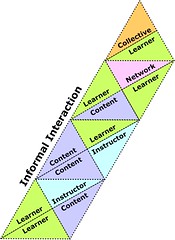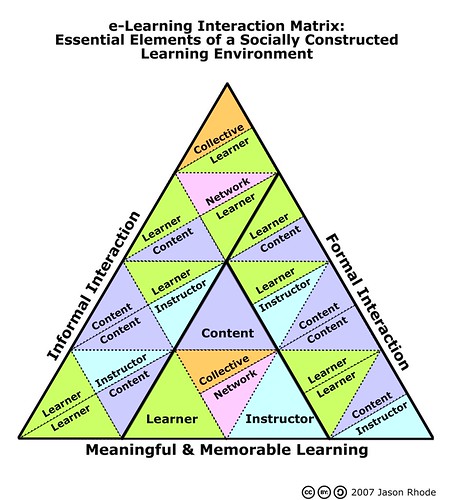As part of my dissertation research, I’ve drafted an interaction matrix that helps explain the dynamic variety of interactions that are often considered essential in fostering a socially constructed learning environment. What follows is the rationale for this model that can serve to help guide the design and development efforts of meaningful and memorable learning environments.
At the core of the interaction matrix are the essential elements of the learning environment: content, learner, instructor, collective, and network.
Many learning endeavors commonly are focused initially upon the integration of course content. The content includes the complete assortment of instructional materials, learning objects, assigned readings, resources, etc. that serve as the reference and resources that the both the instructor and learners will make use of. The instructor and learner(s) complete the triad of essential elements commonly understood as foundational to the learning encounter. Yet, two emerging catalytic components should also be included as core elements that learners interact with in informal contexts: the Network and the Collective.
Anderson and Dron (2007) note the distinctive characteristics of each of these granularities of social organization. They define the network as, “a more fluid form of social entity in which members join, create and remove themselves from numerous informal learning and social connections.” The network is personalized for each learner, as s/he has complete control over the composition of their network, the individuals comprising the network, and the degree to which the network is utilized.
The “Network” is further classified by Downes (2006) as being:
diverse, autonomous, open, connective, and distributed. Downes also notes that that networks serve as bridges among individuals and agents in contrast to groups which isolate individuals into restricted units. Networks are fluid and generative as members contribute to create a resource that has greater value than any individual or group can solely construct. Examples of networks in education might include email mailing lists, social networks, or subscribers to syndicated blogs.
In comparison to the Network, the Collective is much more expansive and involves the bottom-up interactions of the many. Anderson and Dron refer to the Collective as, “The largest form of social granularity in which members participate for individual benefit, but their activities are harvested to generate the ‘wisdom of the crowds’.” Anderson and Dron further note that the Collective is, “a kind of cyber-organism, formed from people linked algorithmically…it grows through the aggregation of individual, Group and Networked activities. This distinctive dynamic is one of aggregation, not networking and the clearest way of distinguishing the two is that collective systems do not require a commitment to the Many.” The Collective might include any type of interactions involving individuals indirectly contributing to the many and can involve such items activities as searching, social bookmarking, ranking, reviewing, and voting.
Formal Interaction
Moore (1989) suggested the existence of three main types of interaction within educational contexts: (1) between the learner and instructor, (2) among learners, (3) between learners and the content they are working to master. A host of subsequent typologies have emerged, each seeking to either extend Moore’s basic tenets of interaction or define additional forms of interaction within the instructional context (see, for example, Anderson & Garrison, 1998; Hannafin, 1989; Hirumi, 2002; Juwah, 2006; Jung, Choi, Lim, & Leem, 2002; Wagner, 1997). The Interaction Matrix draws together the dynamic interactions possible in contemporary online learning environments into a single model that can be utilized in the design, development, and facilitation of online learning initiatives.
In accordance with widespread recommendations from the literature and recommendations from learners (Rhode, 2007), the following formal interactions should be considered when designing online learning:
Instructor-Content Interaction. This involves the wide array of interactions that the instructor has with the content and includes activities such as selecting objectives, developing instructional materials, crafting activities for learners to engage in, etc.
Learner-Learner Interaction. This includes any number of interactions designed to encourage learners to interact with one another throughout the course. These interactions could be either synchronous or asynchronous but the parameters for such activities are generally specified by the instructor or the course requirements.
Content-Content Interaction. Rather than offering just a single set of activities or interactions for all learners, content-content interaction can facilitate custom learning paths through course content and activities, displaying content to certain users for a limited period of time or making additional content available based on the a variety of pre-defined or dyanamic content variables.
Instructor-Learner Interaction. Any number of interactions between learners and the instructor are possible. Such interactions may be either synchronous or asynchronous and can be either instructional, supplementary, or evaluative in nature. No matter the specific format of the interactions, learners have reported finding the interactions with the instructor to be essential to the quality of the online learning experience (Rhode, 2007).
Learner-Content Interaction. As learners actively engage with course content, they have opportunity to evaluate, apply, and synthesize course content. Therefore, the interactions that learners have with content should be carefully designed to facilitate meaningful interactions.
Informal Interaction
In addition to the formal interactions that instructors and designers must consider, numerous informal interactions also are possible and should be considered as contributing to the overall success of the learning encounter and may serve as integral to the quality learning experience preferred by both learners and instructors. These interactions, while some at times exist beyond the control of the designer or instructor, should at least be considered as important components to the complete learning experience.
Learner-Learner Interaction. Learners have opportunity to interaction with each other informally outside of the formal learning environment. These interactions may include, but aren’t limited to: email, phone, meeting in person, sharing or compiling bookmarked resources, social networking, subscribing to each other’s blogs, commenting on each other’s blogs.
Instructor-Content Interaction. In addition to the formal efforts of the instructor to design and develop various course content activities, the instructor may come across additional resources or supplementary course content items that may either add to overall understanding or serve as additional resources. The instructor may engage in a variety of ongoing informal interactions with the content, such as bookmarking new resources, subscribing to and commenting on blogs or news feeds, etc. The instructor may choose to incorporate newly-discovered content and resources immediately to the course in-progress or may utilize them when revising the course for the next group of students.
Content-Content Interaction. Consistent with the characteristics of the Collective described above, a wide assortment of informal interactions among content items can contribute to the learning experience and be leveraged. Such interactions could involve organic interactions such as the formation and updating of dynamic information feeds or agents that are developed and updated by other forms of information or content. As the Collective becomes more clever as technology develops, the format and influence of content-content interactions will only further develop.
Instructor-Learner Interaction. Learners may need to reach out to the instructor informally for further clarification or assistance. Or, the instructor may need to contact students outside the formal course environment to share announcements or updates. A myriad of other informal interactions are possible, all of which may help learners feel more connected to the instructor as well as supported throughout the entire learning experience.
Learner-Content Interaction. Learners have opportunity to interact with content informally, which may serve to help reinforce formal interactions and therefore solidify the efficacy of designed formal learner-content interactions. While each learner’s personal learning environment (PLE) whereby many such interactions take place is unique, it is possible to design opportunities in the learning experience for learners to leverage their PLE to extend formal learning content. such activities might include searching online for related supplementary resources and then bookmarking them to share with the class or subscribing to blogs and other feeds that further extend the knowledgebase.
Learner-Network Interaction. As learners develop their own learning network outside the walls of the formal course environment, they have opportunity to form connections that can support interactions on a number of levels.
Learner-Collective Interaction. Learners can access a myriad of additional informal resources referred to as “the Collective” in which the input of the many can have a significant and dynamic contribution. Learners also can share their perspective with the collective, therefore contributing to the success of
Interaction Matrix
Considering the full range of possible interactions that possible, the Interaction Matrix below depicts the essential elements of a socially constructed learning environment as they are involved in various synergistic interactions. As Sims and Stork (2007) recommend, designers should be cognizant of the unique cultural and situational/social contexts of learners that influence the ability for learners to engage in online learning environments. Emergent designs enable learners to integrate their individuality, experience and culture into the teaching and learning dynamic. Such designs leverage the full suite of interactions possible. Therefore, designers should be aware of each of these potential interactions and incorporate as many such interactions as are possible in an effort to provide learners with the maximum level of control in their learning experience.
This model is a work-in-progress and comments, suggestions, and ideas for further development are certainly welcome. It will be included in chapter five of my dissertation.
References:
Anderson, T., & Dron, J. (2007). Groups, networks, and collectives in social software for e-learning, 2007 European Conferences on E-Learning. Copenhagen, Denmark. Slides available at http://www.slideshare.net/terrya/ecel-copenhagen-2007-terry-anderson.
Anderson, T. & Garrison, D. R. (1998). Learning in a networked world: New roles and responsibilities. In C. C. Gibson (Ed.), Distance learners in higher education: Institutional responses for quality outcomes(pp. 97-112). Madison, WI: Atwood.
Downes, S. (2006). Learning networks and connective knowledge. Retrieved October 16, 2006, from http://it.coe.uga.edu/itforum/paper92/paper92.html.
Hanafin, M. J. (1989). Interaction strategies and emerging instructional technologies: Psychological perspectives. Canadian Journal of Educational Communication, 18(3), 167-179.
Hirumi, A. (2002). The design and sequencing of elearning interactions: A grounded approach. International Journal on E-Learning, 1(1), 19-27.
Jung, I., Choi, S., Lim, C., & Leem, J. (2002). Effects of different types of interaction on learning achievement, satisfaction and participation in web-based instruction. Innovations in Education and Teaching International, 39(2), 153-162.
Juwah, C. (2006). Introduction. In C. Juwah (Ed.), Interactions in online education: Implications for theory and practice (pp. 1-5). New York: Routledge.
Moore, M. G. (1989). Editorial: Three types of interaction. American Journal of Distance Education, 3(2), 1-7.
Rhode, J. F. (2007) Interaction equivalency in self-paced online learning environments: An exploration of learner preferences. Unpublished dissertation.
Sims, R., & Stork, E. (2007). Design for contextual learning: Web-based environments that engage diverse learners. In J. Richardson & A. Ellis (Eds.), Proceedings of AusWeb07. Lismore, NSW: Southern Cross University.
Wagner, E. D. (1997). Interactivity: From agents to outcomes. New Directions for Teaching and Learning, 71, 19-26.







